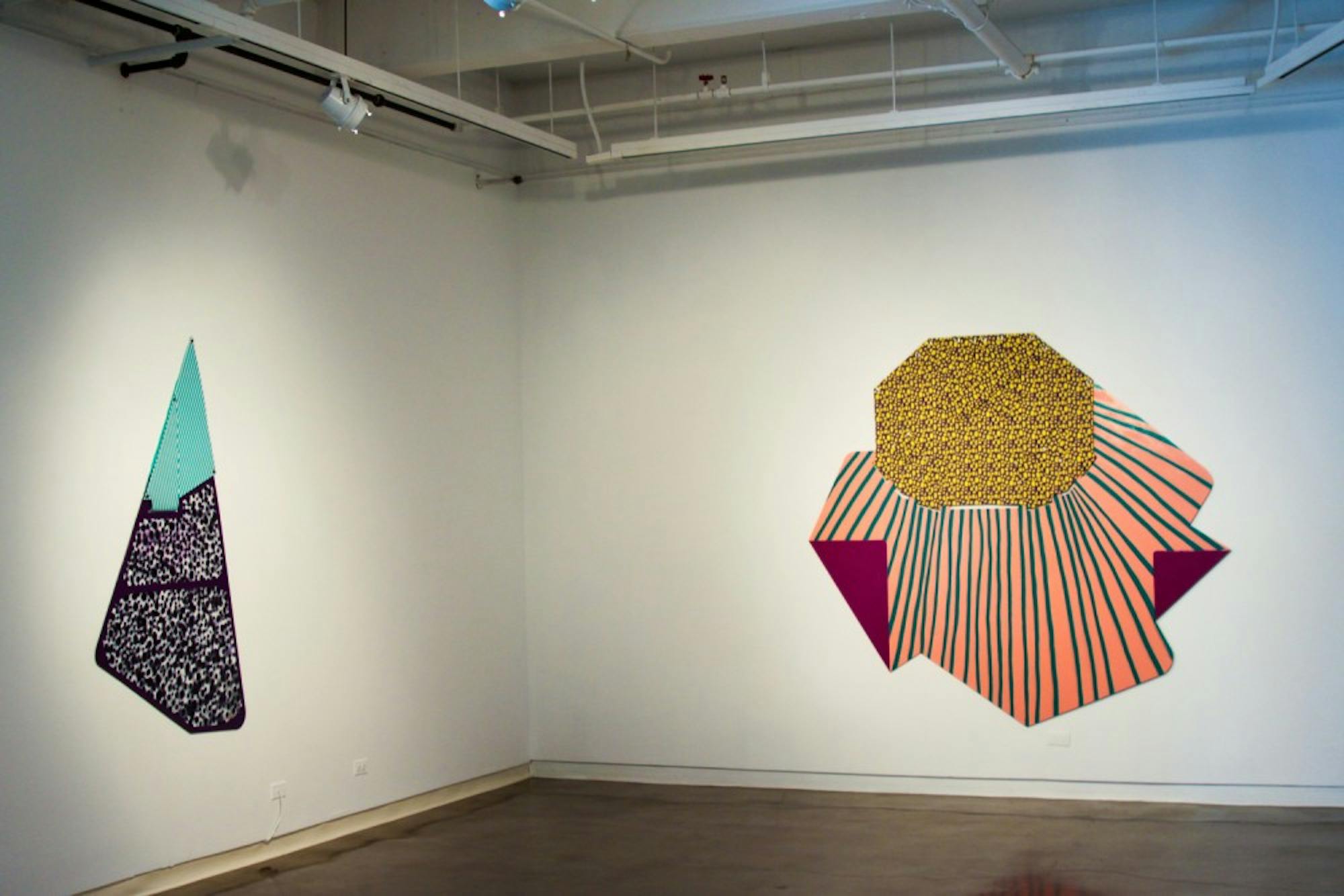A purple octagon with mustard yellow spots draws in the viewer’s eyes. Stepping closer, it becomes apparent the octagon was created from interwoven and overlapping pieces of fabric laid at crisscrossed and parallel directions.
On further inspection, the spots form a pattern of ovals, triangles and semicircles, and around the octagon is an abstracted rose shape radiating non-uniform stripes. Two edges of the abstract shape are folded and appear almost dog-eared, drawing the viewer’s eyes back to those elements of the painting with further questions.
This is just one experience viewing famed abstract artist Ruth Root’s work, now on view in the Jaffe-Friede Gallery. Having exhibited her work in France, Japan, Mexico, the United Kingdom and around the U.S., Root arrives on campus this term as the College’s artist-in-residence, a program that invites professional artists to work and interact with students and faculty.
Root began her career at Brown University studying art semiotics — the study of signs and symbols and how they are used and interpreted in art. She received her master’s in fine arts from the School of the Art Institute of Chicago and attended a residency at the Skowhegan School of Painting and Sculpture.
“I just loved looking at art and making art and thinking [about] what it meant and what it meant to be an artist,” Root said.
Root’s early style focused on the distinction between figure and background, study famously taken up in still lifes by Giorgio Morandi and Paul Cézanne. In such paintings, the figure is separate from the ground due to highlighting and shading, tonal variation that sends some objects forward and others backward.
Noting how some artists become “obsessed” with delineating the figure and background, Root decided to separate the two and move toward abstraction. Her early work included a series of colorful, large-scale geometric shapes painted onto aluminum, blending into the wall where they are displayed since they lack a distinction between foreground and background.
Her work quickly gained notoriety in New York, and in 1996, she received the National Endowment for the Arts’s Mid-Atlantic grant in painting and a painting fellowship from the New York Foundation for the Arts. Three years later, she was invited to display her first New York show at the Andrew Kreps Gallery, which premiered to positive reviews in Time Out New York, The Village Voice and The New York Times.
Working on these paintings, Root developed her own color wheel. While color wheels usually depict blue and orange as opposite colors used together to depict contrast, Root would begin her paintings using brown and pink. In her early work, she never used blue, substituting gray instead.
Some viewers have commented on a connection between the colors in urban cityscapes and the tones in Root’s work. Root described her sense of color as similar to how one may understand a calendar, noticing linear trends throughout a year but also nonlinear associations in between dates and time.
Similarly, colors form unique associations in an artist’s mind, Root said.
“To me, as an artist, color was always a mathematical equation,” Root said. “You kind of solve for what comes forward and what goes back.”
Root has played with the boundary between positive and negative space throughout her career. She has also experimented with inserting eyes into her paintings to confront the viewer. Because photographs of male artists smoking cigarettes fascinate her, she has sometimes incorporated cigarettes into her work.
Her current work concentrates on combining two unlike elements, Plexiglas and fabric. Senior studio art lecturer and director of artist-in-residence program Jerry Auten called viewing Root’s work at the Hopkins Center, which documents this turning point in her career, an especially thought-provoking opportunity.
“[An] artist that paints on Plexiglas, and then weaves the fabric that she designed, and then attaches it to the wall by the fabric — that’s something new,” he said.
Auten said Root is an artist who takes chances, adding, “That’s where the most interesting things happen.”
Studio art professor Enrico Riley distinguished Root’s pieces at the College as “experimental at a very refined level.” Riley commended the artist for maintaining a strong sense of composition while also experimenting with dynamic pattern and color use.
Root will visit various studio art classes and meet with senior studio art majors throughout the term. She hopes to communicate that art is a way of thinking that can permeate everything a person does.
“Being an artist can take many shapes and forms,” she said. “Being a painter doesn’t mean painting portraits or any other preconceived notions.”




